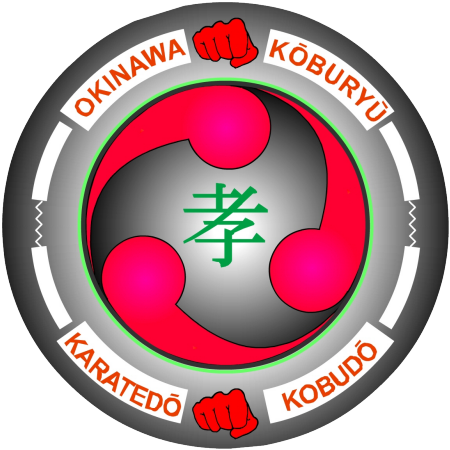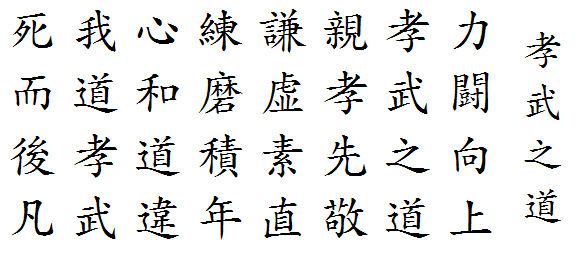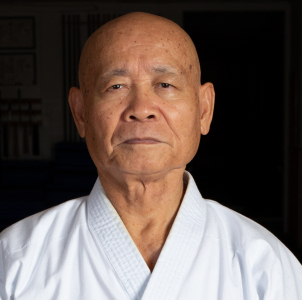Kōburyū Karate
Kōburyū is a modern style of traditional Okinawan karate emphasizing efficient and powerful use of the human body.
Kōburyū was established in the year 2000 by Sōke Kaichō Kinjō Takashi . However, the techniques of Kōburyū did not burst into existence in 2000. Sōke Kaichō Kinjō Takashi spent much of his karate career studying and teaching in the Uechi Ryū family of Okinawan karate. After over 40 years of in-depth analysis, his movement and techniques had taken a path inherently different from that of Uechi Ryū. That difference became Kōburyū, a practical style of modern karate emphasizing efficient and powerful use of the human body.
Because Kōburyū is very new, it is important to not just practice but to study in depth how we are different and, more importantly, why the differences are better. Sōke Kaichō Kinjō states that he practices more than other style’s masters because Kōburyū is his own style. He is still developing his ideas.
Sōke Kaichō KinjōTakashi
Founder of Kōburyū
President of Okinawa Kōburyū Karatedō Kobudō Kōbukai
How should we address Kinjō Takashi?
| Kaichō | 会長 |
| Sōke Kaichō | 宗家会長 |
As a sign of respect, we address Kinjō Takashi as Kinjō Kaichō.
Kaichō is a title meaning president of a society, in this case the society is our international organization.
More accurately, Kinjō Kaichō is Sōke Kaichō Kinjō. Sōke Kaichō indicates that he is both originator of the style and current president of the organization.
What does the name, Takashi, mean?
| Kinjō Takashi | 金城 孝 |
| Kinjō | 金城 |
| Takashi | 孝 |
Kinjō Takashi is written in the Japanese manner, with family name first and given name second. Therefore, Takashi is Sōke Kaichō Kinjō’s given name. A man’s given name is written in Chinese characters called kanji. Kanji are used in everyday writing and have meaning. The kanji for Takashi means filial piety.
Filial piety is an attitude of respect for parents and ancestors in Eastern societies influenced by Confucian thought. Reverence for ones’ parents is considered in Chinese ethics the prime virtue and the basis of all human relations. In Western societies we have a concept like filial piety that refers to a child’s obligation toward his or her parents, particularly the adult children toward their elderly and needy parents.
What does the name, Kōburyū, mean?
| Kōburyū | 孝武流 |
| Kō | 孝 |
| Bu | 武 |
| Ryū | 流 |
The Chinese character (kanji) for Takashi is also pronounced kō, as found in our style name, Kōburyū . Kō, then, is a reference to Sōke Kaichō Kinjō’s first name, Takashi.
“Bu” can mean the art of war, but it also refers to the martial arts. Since karate was never an art of war but always an art of personal defense, the second definition is more appropriate.
Ryū means style.
Therefore, Kōburyū loosely means “Kō’s Martial Arts Style or “Takashi’s Martial Arts Style.”
What is the name of our karate and kobudō organization?
| Okinawa | 沖縄 |
| Kōburyū | 孝武流 |
| Karatedō | 空手道 |
| Kobudō | 古武道 |
| Kōbukai | 孝武会 |
The name of our karate organization is :
Okinawa Kōburyū Karatedō Kobudō Kōbukai
沖縄孝武流空手道古武道孝武会
The headquarters of our karate organization is Kinjō Kaichō’s dojo in Okinawa, Japan. His dojo is therefore called the honbu dojo, the headquarters dojo.
Kōburyū, Modern or Traditional?
How can a karate style be both modern and traditional at the same time? Most karate masters of today are content to simply pass on exactly what was taught to them in exactly the way that it was taught to them. This is not true to the history of the fighting arts of Okinawa. Historically, the fighting arts of ancient Okinawa were never static. Okinawa was a land of seafarers. Ideas from Japan, Korea and the many fighting arts of Southeast Asia became incorporated into the native Okinawan fighting art called te (ti in the Okinawan dialect). As a protectorate of the powerful Ming Dynasty of China, the Okinawan fighting arts were especially influenced by Chinese kung fu. The effectiveness of the Okinawan fighting arts derived from this great melting pot of ideas and methodologies.
Sōke Kaichō Kinjō believes that karate should continue to be an evolving art. Like the karate masters of old, he has continued to analyze and incorporate new ways to generate power and effectiveness while remaining true to the roots of karate.
Kōburyū Includes Both Karate and Kobudō
Kobudō is the study of the weapons of ancient Okinawa. Historically, a dojo would offer either karate or kobudō, but not both. The Uechi Ryū organization itself suffered internal conflict and splintered over the teaching of kobudō in a Uechi Ryū dojo. These days, due to the growing popularity of kobudō, you will find dojos that offer both, but the karate style and the kobudō style are different.
Sōke Kaichō Kinjō started training in kobudō under Matayoshi Shimpo at nearly the same time as he started Uechi Ryū training. It was unusual for a student of that era to study both karate and kobudō . Indeed, Itokazu Seiki, Sōke Kaichō Kinjō’s Uechi Ryūo sensei, once told his young protégée that the practice of kobudō would ruin his karate technique. Far from it, Sōke Kaichō Kinjō came to believe that karate and kobudō are like two halves of the same coin. He felt that karate and kobudō not only could but should be taught as one style. Therefore, Kōburyū offers a unified approach to both karate and kobudō.
The Kōburyū Logo
The official logo has a lot to say about our Kōburyū organization.

The Central Character, Kō
The Chinese character for kō is featured in the center. Kō is another pronunciation of the kanji for Sōke Kaichō Kinjō’s given name, Takashi. Kō means filial piety, a quality that is important to Sōke Kaichō Kinjō. Simplified, this means that you should honor your parents, teachers and other important people in your life.
Why Karate-dō and Not Karate-jutsu?
The word karate-dō emphasizes that it is not just the physical aspects of karate, but also the balance of the physical and mental. Karate-jutsu is all about fighting. Failure is not acceptable. The combat in karate-dō is not against an external enemy, but against yourself. Sōke Kaichō Kinjō says polish yourself, but he also says practice as though your life depends upon it.
Fists
The fists represent karate. The fists representing karate are equally balanced with the nunchaku, emphasizing the equal importance of karate and kobudo to Kōburyū.
Nunchaku
Stylized nunchaku represent all of kobudō, not just the nunchaku. Both the fists and nunchaku are equally featured in the logo, emphasizing the equal importance of karate and kobudo to Kōburyū .
Three commas
The three red interlocked comma-shaped figures are called mitsu domoe (三つ巴 or 三つ鞆絵). You can think of these three as representing shingitai – mind, technique and body. To perform karate well and to understand it properly you have to harmonize these three things within you. The mitsu domoe in Japanese culture typically rotates counterclockwise. The clockwise rotation represents Okinawa.
The Path of Kōburyū – A Poem by Sōke Kaichō Kinjō
This poem written by Sōke Kaichō Kinjō speaks of his values and his hopes for the future of Kōburyū.
The Way of Kōbu
The struggle to improve
Is the way of Kōbu.
Show respect and propriety
For parents and those who came before.
Continuously polish over many years
Humility and purity of heart.
Value harmony with others.
Though you may take a different path
My own way is Kōbu.
It will continue even after my death.
Read from right to left. Every two columns is a statement. The right-most column is the title, “Kōbu no Michi.”

| shi | waga | shin | ren | ken | shin | kō | riki | kō |
| ji | michi | wa | ma | kyo | kō | bu | tō | bu |
| kō | kō | dō | seki | su | sen | no | kō | no |
| bon | bu | i | nen | nao | kei | michi | jō | michi |

